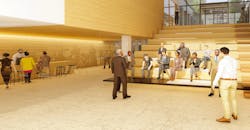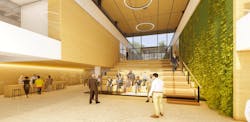ASHRAE Challenges Itself to Live Its Mission
HPAC Engineering has, in the past, highlighted many high-performance buildings. Recently, those considered most significant in terms of energy efficiency and overall sustainability have included the United Technologies Center for Intelligent Buildings in Florida, the Bullitt Center in Oregon, the Unisphere in Maryland, and Viega’s new seminar center and North America HQ in Colorado.
But what makes those buildings so significant? In determining a building’s energy efficiency, it will generally be compared to the requirements in ASHRAE Standard 90.1: Energy Standard for Buildings Except Low-Rise Residential Buildings. And its indoor air quality will have to meet or exceed the requirements of ASHRAE Standard 62.1: Ventilation for Acceptable Indoor Air Quality. Perhaps the best-known standard for green buildings is ASHRAE Standard 189.1: Standard for the Design of High-Performance Green Buildings. In fact, most high-performance commercial buildings may meet or exceed the requirements of as many as half-a-dozen or more ASHRAE standards.
As most in our industry know, ASHRAE is the American Society of Heating, Refrigerating and Air-Conditioning Engineers. It is an international nonprofit composed of mechanical engineers, technicians, manufacturers’ employees, building managers, and others involved in the design, manufacture, installation, service, and operation of HVACR systems and equipment. ASHRAE is a leading developer and promulgator of technical standards relevant to the HVACR industry, and has 190 chapters in over 132 countries, with more than 57,000 members. The organization publishes more than 4,000 documents: standards, handbooks, guidelines, journals, newsletters, and others. ASHRAE also publishes the Advanced Energy Design Guide (AEDG) for Zero Energy Office Buildings.
Its present headquarters in Atlanta GA underwent a significant renovation in 2008, achieving an Energy Star score of 95 (meaning it was more efficient than 95 percent of its peer buildings) and LEED Platinum certification. By using such high-efficiency technologies as ground source heat pump (GSHP) and variable refrigerant flow (VRF), the building was able to reduce its energy consumption by 60 percent.
The new headquarters, also in the Atlanta area, will be in a building originally constructed in 1978. The two-story, 66,700-sq-ft office building will be completely renovated, with the goal of net-zero energy (NZE), following their own AEDG for Zero Energy Office Buildings. In fact, ASHRAE intends to exceed all of its own energy and indoor environmental standards and guidelines, in order to achieve a high-performing, energy-efficient and environmentally sustainable building that will incorporate the most advanced, commercially available HVACR technologies.
Specifically, the renovated building is expected to exceed the minimum outdoor air requirements of ANSI/ASHRAE Standard 62.1-2016, Ventilation for Acceptable Indoor Air Quality by 130 percent and lighting power density (LPD) in open offices is being designed to be 35 percent lower than that required by ANSI/ASHRAE/IES Standard 90.1-2016, Energy Standard for Buildings Except Low-Rise Residential Buildings. The facility is also expected to exceed the requirements of ANSI/ASHRAE Standard 55-2017, Thermal Environmental Conditions for Human Occupancy, ensuring the comfort of its projected 125 occupants. As would be expected, the building will be commissioned in accordance with ASHRAE Guideline 0-2013, The Commissioning Process, and ASHRAE Guideline 1.1-2007, HVAC&R Technical Requirements for the Commissioning Process.
The design team for the project consists of a partnership of McLennan Design, Bainbridge Island WA, and Atlanta-based Houser Walker Architecture, in collaboration with engineer Integral Group, Oakland CA. CEO Jason McLennan, author of USGBC’s Living Building Challenge leads the architectural design, and architect Greg Walker leads the interior design. The project is expected to be completed in October 2020.
Kudos to ASHRAE for walking the walk!
A regular contributor to HPAC Engineering and a member of its editorial advisory board, the author is a principal at Sustainable Performance Solutions LLC, a south Florida-based engineering firm focusing on energy and sustainability. He can be reached at [email protected].
SIDEBAR: AMBITIOUS GOALS FOR ASHRAE’S NEW HQ
When it opens in October 2020, the newly renovated headquarters building will become a showcase for the latest HVACR equipment and technology, says ASHRAE. It will provide a destination venue for industry visitors and members to experience state-of-the-art technology installed and “in action” in a built environment.
The purchased building, constructed in 1978, sits on 11 acres and offers 66,700 sq. ft. of office space. The two-story structure, including a partial basement, will be designed to provide space for approximately 125 occupants and have a serviceable life of at least 50 years. Selected materials will be capable of withstanding Atlanta’s hot, humid weather conditions. The retrofitted HQ will represent the sustainability values which ASHRAE has long held, and will have a ‘zero carbon’ footprint.
Some key project goals for the new building are:
- To demonstrate how to transform older existing buildings from dated workplace environments to high-performance workplace environments;
- To showcase an affordable, net-zero energy strategy;
- To provide energy, demand and environmental data via web interface;
- To be visible, when and where appropriate, within the building as an education tool;
- To provide additional sensors and monitoring capability in spaces such as conference rooms, so the data obtained can support investigations and experimental work for ASHRAE research. This includes electronic data storage and manipulation capability and a meteorological monitoring station;
- To provide provisions for a building automation system (BAS);
- To showcase an ASHRAE Building EQ A+ rating;
- To provide a building environment that sets new standards for worker productivity and wellness through superior visual acuity, daylight, acoustics, thermal comfort and air quality.
Source: ASHRAE. For updates, go to ashrae.org/newhq.
About the Author
Larry Clark
A member of HPAC Engineering’s Editorial Advisory Board, Lawrence (Larry) Clark, QCxP, GGP, LEED AP+, is principal of Sustainable Performance Solutions LLC, a South Florida-based engineering firm focused on energy and sustainability consulting. He has more than two dozen published articles on HVAC- and energy-related topics to his credit and frequently lectures on green-building best practices, central-energy-plant optimization, and demand-controlled ventilation.



